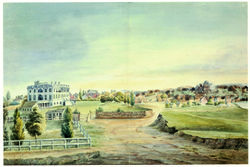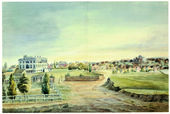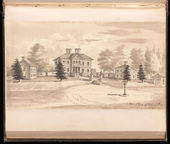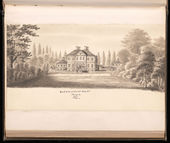Difference between revisions of "Anthony St. John Baker"
| Line 1: | Line 1: | ||
| − | {{#set: | + | {{#set:date=1785}} |
'''[[Anthony St. John Baker]]''' (1785–May 16, 1854), was the English diplomat who carried the Treaty of Ghent to the United States at the close of the War of 1812. During his years of official service in Europe and America, Baker recorded his impressions in written accounts as well as watercolor sketches, several representing gardens and landscaped grounds, which he ultimately published as the autobiographical ''Mémoires d’un voyageur qui se repose'' (''Memoirs of a Traveler Now in Retirement'') in 1850. | '''[[Anthony St. John Baker]]''' (1785–May 16, 1854), was the English diplomat who carried the Treaty of Ghent to the United States at the close of the War of 1812. During his years of official service in Europe and America, Baker recorded his impressions in written accounts as well as watercolor sketches, several representing gardens and landscaped grounds, which he ultimately published as the autobiographical ''Mémoires d’un voyageur qui se repose'' (''Memoirs of a Traveler Now in Retirement'') in 1850. | ||
Revision as of 15:20, May 31, 2018
Anthony St. John Baker (1785–May 16, 1854), was the English diplomat who carried the Treaty of Ghent to the United States at the close of the War of 1812. During his years of official service in Europe and America, Baker recorded his impressions in written accounts as well as watercolor sketches, several representing gardens and landscaped grounds, which he ultimately published as the autobiographical Mémoires d’un voyageur qui se repose (Memoirs of a Traveler Now in Retirement) in 1850.
History
Educated at Oxford, Baker began his diplomatic career in Europe.[1] He arrived in America in 1811 to serve as British secretary of legation and immediately began writing the detailed accounts of people, places, and events that are now a rich source of historical information about early 19th-century America. When the British minister returned to England upon the declaration of war in 1812, Baker stayed on to act as agent for captured British prisoners.[2] He indirectly contributed to the foundation of the Pennsylvania Academy of Arts when, in 1813, he lobbied for the return of a cargo of 21 paintings and 52 prints–part of the Academy’s foundational collection—which the British navy had seized from an American ship en route from Rome to Philadelphia.[3] Accused variously of spying, smuggling correspondence, and licensing illegal trade between American ship owners and Britain, he left the country in 1813.[4]
Baker returned to the United States in 1815 as Chargé d’Affaires, responsible for obtaining American ratification of the Treaty of Ghent. He advanced to the position of Consul General the following year.[5] Over the next decade, Baker’s drawings and written accounts attest to his keen interest in the physical environment of the United States as well as its political and social life. He documented the evolving city of Washington in three drawings made in 1826, including one representing the newly rebuilt and relandscaped White House [Fig. 1] in which it is possible to discern part of the arboretum laid out by President John Quincy Adams.[6]
Baker also created verbal and visual accounts of the country seats of prominent American families. Around 1820, while courting George Calvert’s daughter Caroline, he made a watercolor drawing of the family’s Maryland estate, Riversdale—the earliest known pictorial representation of the house—which was published as a transfer lithograph in London in 1827 [Fig. 2].[7] Baker visited several of the Virginia properties of the Tayloe family, including Mount Airy, where he noted the large conservatory (“with orange and lemon trees put out on the grass”) and an “extensive garden,” laid out “in squares and terraces, according to the fashion of that period,” and “in front, lawn planted, and terrace, with flowers on pedestals.” While the gentlemen of the neighborhood devoted themselves to horse racing, Baker preferred to accompany the ladies in exploring the grounds, “strolling over the garden before tea” on one evening, and on the next, taking “a long walk in the evening, with the ladies, in the park; thickly wooded, and many fine deer.” The brevity of his visit prevented Baker from accepting Robert Carter’s invitation to visit his neighboring house, Sabine Hall.[8]
Baker took a leave of absence from Washington in 1828 and officially resigned his post in 1831.[9] Retiring to Tunbridge Wells, England, he compiled Mémoires d’un voyageur qui se repose, published privately in 1850 in a limited edition of fifty copies. The four-volume set included numerous engravings after Baker’s watercolors, along with maps and other illustrations.[10] A collector of coins and medals, Baker was elected to the Numismatic Society in 1842, and actively supported the British Archaeological Association from its first congress in 1844.[11] Baker also subscribed to the seven-volume Collectanea Antiqua (1850).[12] His “valuable assemblage of coins and medals” and his “select library” of books relating to the history, laws, and statistics of the United States were auctioned by Messrs. S. Leigh Sotheby and John Wilkinson in December 1854.[13]
—Robyn Asleson
Images
Other Resources
Library of Congress Authority File
Notes
- ↑ James B. Childs, “Mémoires d’un Voyageur Qui Se Repose: A Bibliographical Interlude on an Elusive Foreign Service Officer’s Impressions of the United States, 1811–1832,” The Papers of the Bibliographical Society of America 64 (1970): 194, view on Zotero; Joseph Foster, Alumni Oxienses: The Members of the University of Oxford, 1715–1886, 4 vols. (London: Joseph Foster, 1887), 1:50, view on Zotero; “Proceedings of the Numismatic Society. Session 1853–1854,” The Numismatic Chronicle and Journal of the Numismatic Society, 17 (1854–1855): 15, view on Zotero.
- ↑ James Stephen Krysiek, “The Diplomatic Career of Sir Charles Bagot. The Early Years: London, Paris, Washington, St. Petersburg (1807–1824)” (PhD diss., Marquette University, 1988), 182, view on Zotero; Ira Dye, “American Maritime Prisoners of War, 1812–1815,” in Ships, Seafaring, and Society: Essays in Maritime History, ed. Timothy J. Runyan (Detroit: Wayne State University Press, 1987), 306, view on Zotero; William H. Masterson, Tories and Democrats: British Diplomats in Pre-Jacksonian America (College Station, TX: Texas A&M University Press, 1985), 150, 165, view on Zotero; Charles O. Paullin and Frederic L. Paxon, Guide to the Materials in London Archives for the History of the United States since 1783, Papers of the Department of Historical Research (Washington, DC: Carnegie Institution of Washington, 1914), 35, 37, 39, view on Zotero.
- ↑ John Henry Merryman and Albert Edward Elsen, Law, Ethics, and the Visual Arts, 4th ed. (Norwell, MA: Kluwer Law International, 2002), 11, view on Zotero; E. P. Richardson, “Allen Smith, Collector and Benefactor,” American Art Journal 1 (1969), 11–14, view on Zotero.
- ↑ Allan Seymour Everest, The War of 1812 in the Champlain Valley (Syracuse, NY: Syracuse University Press, 2010), 79, view on Zotero; Masterson 1985, 176, view on Zotero; Childs 1970, 197, view on Zotero; George Lockhart Rives, ed., Selections from the Correspondence of Thomas Barclay, Formerly British Consul-General at New York (New York: Harper & Brothers, 1894), 310, view on Zotero.
- ↑ Troy Bickham, The Weight of Vengeance: The United States, the British Empire, and the War of 1812 (New York: Oxford University Press, 2012), 3, 262, view on Zotero; Paullin and Paxin, 40–41, view on Zotero.
- ↑ Therese O'Malley, “Art and Science in American Landscape Architecture: The National Mall, Washington, DC, 1791–1852“ (PhD diss., University of Pennsylvania, 1989), 119, view on Zotero.
- ↑ Margaret Law Calcott, Mistress of Riversdale: The Plantation Letters of Rosalie Stier Calvert, 1795–1821 (Baltimore: The Johns Hopkins University Press, 1992), 359, view on Zotero.
- ↑ Benjamin Ogle Tayloe, In Memoriam: Benjamin Ogle Tayloe (Philadelphia: Sherman & Co., Printers, 1872), 245–46, view on Zotero.
- ↑ “Proceedings of the Numismatic Society” 15, 65–66, view on Zotero.
- ↑ Copies of Baker’s valuable and extremely rare memoirs are held by the Huntington Library (extra-illustrated with 18 of his watercolors); Yale University Library (also extra-illustrated); New-York Historical Society; William L. Clements Library, University of Michigan. See Childs 1970, 198–204, view on Zotero; Carey S. Bliss, “Acquisitions: July 1–November 15, 1952,” Huntington Library Quarterly 16 (1953): 216, view on Zotero.
- ↑ “Proceedings of the Numismatic Society. Session 1842–43,” The Numismatic Chronicle and Journal of the Numismatic Society 5 (1842–1843): 57, 62, view on Zotero; for Baker’s subscription to the Journal of the British Archaeological Association and his participation in the Association’s congresses, see “Obituary for 1854,” The Journal of the British Archaeological Association 11 (1855): 60, view on Zotero.
- ↑ Charles Roach Smith, Collectanea Antiqua: Etchings and Notes on Ancient Remains, 7 vols. (London: J. Russell Smith, 1852), view on Zotero.
- ↑ Athenaeum (December 8, 1854), 1478; “Obituary for 1854,” 60, view on Zotero.







